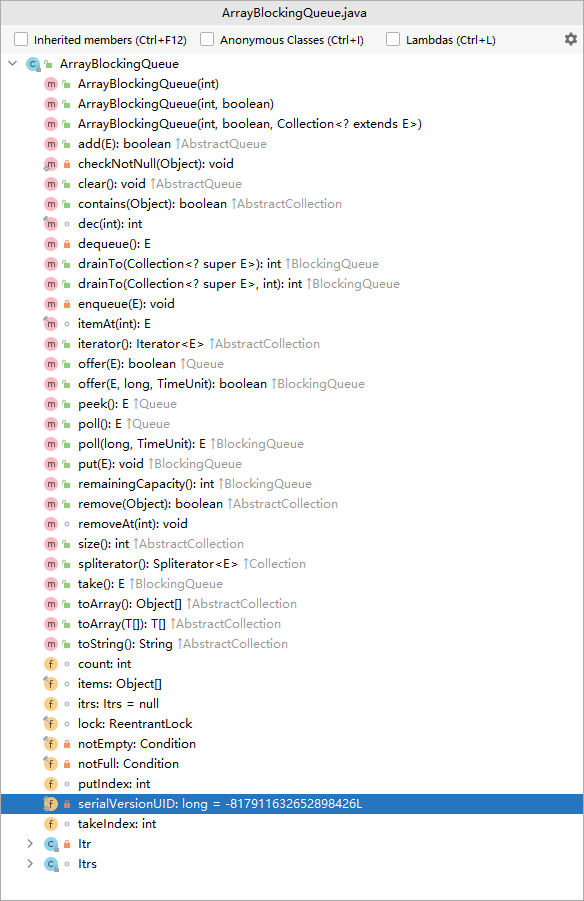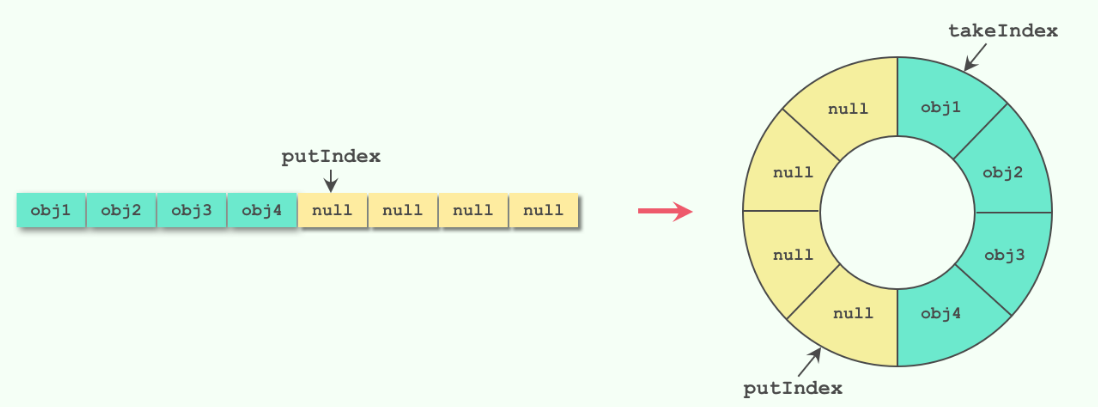ArrayBlockingQueue ArrayBlockingQueue是最典型的有界阻塞队列,其内部是用数组存储元素的,初始化时需要指定容量大小,利用 ReentrantLock 实现线程安全。
在生产者-消费者模型中使用时,如果生产速度和消费速度基本匹配的情况下,使用ArrayBlockingQueue是个不错选择;但如果生产速度远远大于消费速度,则会导致队列填满,大量生产线程被阻塞。
使用独占锁ReentrantLock实现线程安全,入队和出队操作使用同一个锁对象,也就是只能有一个线程可以进行入队或者出队操作;这也就意味着生产者和消费者无法并行操作,在高并发场景下会成为性能瓶颈。
ArrayBlockingQueue:有界阻塞队列,先进先出,存取相互排斥
数据结构:静态数组
容量固定必须指定长度。没有扩容机制
没有元素的位置也占用空间,被null占位
锁(ReentrantLook):存取是同一把锁,操作的是同一个数组对象,存取互相排斥
阻塞对象:
notEmpty:出队:队列count=0,无元素可取时,阻塞在该对象上
notFull:入队:队列count=length,放不进去元素时,阻塞在该对象上
两个操作:
入队:从队首开始添加元素,记录putIndex(到队尾时设置为0)唤醒notEmpty
出队:从队首开始提取元素,记录takeIndex(到队尾时设置为0)唤醒notFull
两个指针都是从队首向队尾移动,保证队列的先进先出原则
基本使用 1 2 3 BlockingQueue queue = new ArrayBlockingQueue(1024 ); queue.put("1" ); Object object = queue.take();
实现原理 数据结构
利用了Lock锁的Condition通知机制进行阻塞控制。
核心:一把锁,两个条件
1 2 3 4 5 6 7 8 9 10 11 12 13 14 15 16 17 18 19 20 21 22 23 24 final Object[] items;int takeIndex;int putIndex;int count;final ReentrantLock lock;private final Condition notEmpty;private final Condition notFull; public ArrayBlockingQueue (int capacity) this (capacity, false ); } public ArrayBlockingQueue (int capacity, boolean fair) ... lock = new ReentrantLock(fair); notEmpty = lock.newCondition(); notFull = lock.newCondition(); }
入队put方法
1 2 3 4 5 6 7 8 9 10 11 12 13 14 15 16 17 18 19 20 21 22 23 24 25 26 27 28 public void put (E e) throws InterruptedException checkNotNull(e); final ReentrantLock lock = this .lock; lock.lockInterruptibly(); try { while (count == items.length) notFull.await(); enqueue(e); } finally { lock.unlock(); } } private void enqueue (E x) final Object[] items = this .items; items[putIndex] = x; if (++putIndex == items.length) putIndex = 0 ; count++; notEmpty.signal(); }
出队take方法 1 2 3 4 5 6 7 8 9 10 11 12 13 14 15 16 17 18 19 20 21 22 23 24 25 26 27 28 public E take () throws InterruptedException final ReentrantLock lock = this .lock; lock.lockInterruptibly(); try { while (count == 0 ) notEmpty.await(); return dequeue(); } finally { lock.unlock(); } } private E dequeue () final Object[] items = this .items; @SuppressWarnings ("unchecked" ) E x = (E) items[takeIndex]; items[takeIndex] = null ; if (++takeIndex == items.length) takeIndex = 0 ; count--; if (itrs != null ) itrs.elementDequeued(); notFull.signal(); return x; }
环形数组



Copyright 2021 sunfy.top ALL Rights Reserved